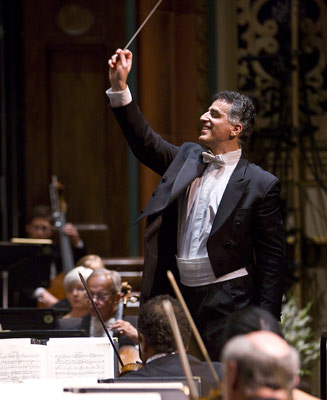Santa Barbara Symphony Begins Granada Season
S.B. Symphony Plays Broughton, Beethoven, and Mahler

It was only fitting that this inaugural concert of the Santa Barbara Symphony’s new season at the Granada began with a world premiere. The piece, Fanfares: Mosaic for Orchestra, by the Emmy Award-winning composer Bruce Broughton, began with a blast from trumpets positioned in the two top boxes at the front of the room, high above the audience and the orchestra. From their remote perches, the horns lent a festive air to the proceedings while emphasizing the Granada’s extraordinary acoustics. The middle, slower section achieved a contemplative grace that reached its apex with a beautiful flute solo. And when the final section kicked in, the hall reverberated with an overwhelming ringing of brass as the piece moved into what the composer termed “a brilliant cacophony of competing fanfares.” Broughton has a great touch and managed to straddle the divide between the elaborate and a concerto without strain, showing off both the orchestra and the space to great effect.
Beethoven’s Concerto for Piano, Violin, Cello, and Orchestra in C Major, Op. 56 followed, featuring the afternoon’s guest artists, the Perlman/Schmidt/Bailey Trio. This extraordinary work represents the fulfillment of Beethoven’s middle or “heroic” period, and is chock full of drama and surprise. Navah Perlman dispatched the piano part with elegance, while her collaborators, Giora Schmidt (violin) and Zuill Bailey (cello), were left to do most of the virtuosic heavy lifting. Schmidt shone in the “Allegro” and “Largo” sections, while Bailey took the spotlight for the final “Rondo alla Pollaca” section. It was here that the orchestra blended masterfully with the trio, in turn heightening the classic composition.
The best, however, was yet to come. After the intermission, the orchestra returned in an augmented form (replete with massive bass section) for Gustav Mahler’s Symphony No. 1 in D Major. This massive, lengthy work gave Maestro Nir Kabaretti and the orchestra a fine opportunity to demonstrate just how far they have come in the seasons since he arrived. The impact of Mahler’s work depends on how well its sophisticated sonorities are realized, and the symphony made them sing. The third movement, which begins with a drawn-out folk tune and then modulates through several outrageous parodies, required tremendous precision and confidence, which were amply present. And the finale, with its overpowering horn blasts, made for a joyous moment of celebration for the audience, which was properly delighted both with the music and the setting.



